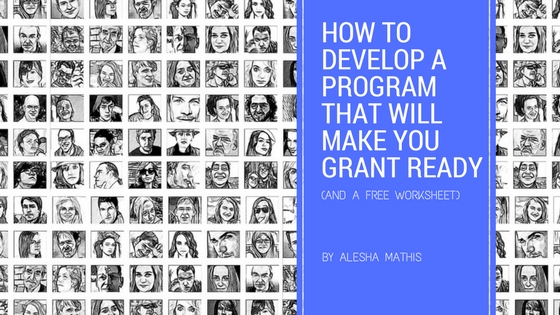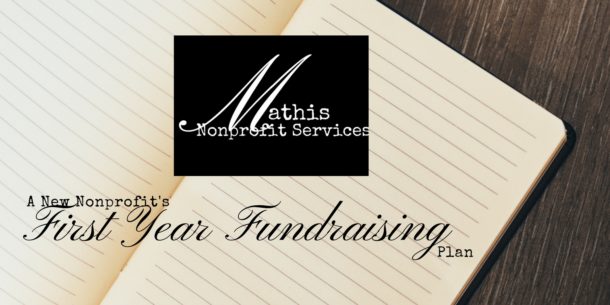You got into nonprofit work to not just do something about a problem but to solve it. Programs are how you do something about a problem and they serve as your proof of concept. Developing a program is crucial to your organization’s prosperity. Programs allow you to deliver a service and measure its success.
Most grants you write will be to fund your program. So where do you begin if you have to start a program from scratch? The Program Worksheet I designed will help you think through a program that grantors and donors will want to fund. It sets you up to automatically define and measure your success.
Let’s look at a Program.
Establish a Background for the Formation of the Program
Establishing a background on the formation of the project will help you keep a history of the project. Explain why your organization has created the program and any rationale used. This will help keep you away from the “because we’ve always done it” mentality. Keep in mind programs have a lifespan and will eventually evolve or need to be dropped. It’s okay. Needs change.

What is the Purpose of the Program?
What is the need and how did you establish this need? Some organizations will commission a needs assessment. Sometimes it can be as easy as surveying your clients or potential clients to see which needs are most important to your ideal client.
You will also want to spell out how this program fits the organization’s mission and how it furthers the mission. You always want programs that do at least one of those two things. Otherwise, you are spending money on a program that will not get you anywhere.
Establish the Nuts and Bolts of the Program
This is the nitty-gritty of the program. Make sure you really think through how the program will work and minimize any risks you see. Here are some questions you will want to ask yourself:
- Who are your clients? Give demographics here.
- Where will your clients come from? You will need to think this through because it will help you in your marketing later.
- What challenges will they have getting in your program or even physically getting to your program? How can your program eliminate those barriers?
- What is the program budget? How much will you need to get started? You may be able to apply for grants early on if you look for Foundations who give for seed money or program development. If you are a brand new organization, you will need to attach a Five Year Strategic Plan to the grant. You may consider prequalifying people and putting them on a wait-list dependent on funding. This could help you establish a real need in your grant.
- What facilities and equipment will you need?
- What program staff will be needed? Will they be paid or volunteer? Will you need insurance? Do you have insurance?
- What is your process or how will the services be delivered? This question is asking- from the application to coming off your client list- what are the steps a client will take? From an organization perspective, what steps will need to be taken?
- Are there any regulations you have to comply with? Write them in the plan.
- How do you qualify the participants? How will you narrow your scope to help the most clients with the resources you have?
- How will you evaluate the program? This is extremely important so you know if the program is a success. You will also have the data to prove the success. Again, programs have a shelf life. You will need to know when to grow a program and when to close a program. Program evaluation is necessary.
- Once an evaluation has occurred, how will change recommendations be made and implemented in the program?
- What are your outputs or units of service? Are you counting people or families who successfully completed the program, houses built, meals served, etc?
- Is there any growth potential? Do you establish a wait-list that will give you firm numbers on growth potential?
- What are the expected (and later actual) outcomes or impacts on the clients being served? Give firm numbers along with intangible impacts. An example for a homebound meal recipient maybe a 30% decrease in medication due to healthy eating and an increased sense of independence knowing they will not have to go to a nursing home. These statistics should be measured in the evaluations.
I’m Done, Right?
Well, sort of. You are done writing the program. You will still have to get it passed by the Board and there may be some revisions to get it passed. But it’s a start. There are still some activities you will need to do.
Create Deliverables
Deliverables are all the tangible items you outlined in your plan. Did you say there would be an application for clients to fill out? Was that a paper and online form? Were there forms to be signed off on for accountability? Is a written policy or process needed? Are there regulations that need to be followed? Were there forms to measure progress? What evaluation forms need to be created? It’s important to include these as an appendix to the program document.
Market Your Program
You’ve done all this work and now it’s time to market the program. You will have to think about marketing on two fronts. You will need to brainstorm marketing ideas to potential clients and donors.


 Most nonprofit leaders lay awake at night trying to figure out how to fund their mission.
Hi! I'm Alesha.
I teach sustainable fundraising in a way that they can take action today so they can serve their clients.
I can help you move from just getting started funding your new nonprofit to gaining confidence in your fundraising and building relationships to knowing what works for your organization and looking at the infinite game when it comes to funding. I’ve worked with nonprofit Founders and written the book I HAVE MY 501(C)3! NOW WHAT?!? Your Blueprint to Starting Your Nonprofit Without Being the Sole Funder that lays the foundations for funding in a new nonprofit.
I’ve worked in Development (Fundraising) Departments in large organizations and I know the no cost, low-cost methods they use to bring in funding. I bring those sound strategies to the nonprofits I serve.
Most nonprofit leaders lay awake at night trying to figure out how to fund their mission.
Hi! I'm Alesha.
I teach sustainable fundraising in a way that they can take action today so they can serve their clients.
I can help you move from just getting started funding your new nonprofit to gaining confidence in your fundraising and building relationships to knowing what works for your organization and looking at the infinite game when it comes to funding. I’ve worked with nonprofit Founders and written the book I HAVE MY 501(C)3! NOW WHAT?!? Your Blueprint to Starting Your Nonprofit Without Being the Sole Funder that lays the foundations for funding in a new nonprofit.
I’ve worked in Development (Fundraising) Departments in large organizations and I know the no cost, low-cost methods they use to bring in funding. I bring those sound strategies to the nonprofits I serve.